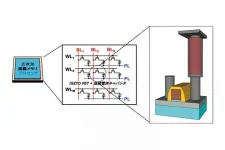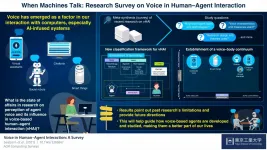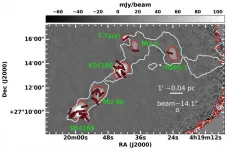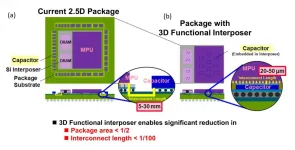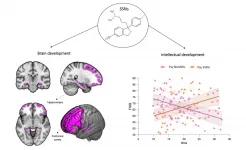(Press-News.org) A research team led by scientists at Université de Montréal has developed a unique observational tool for assessing children up to 5 years of age who have had a concussion. The work is explained in a study published in the Journal of Head Trauma Rehabilitation.
Pediatric traumatic brain injury (TBI) is particularly prevalent in toddlers; they're more likely to be injured because they have a lower sense of danger and are still developing physically. But parents and clinicians have trouble detecting symptoms of trauma, given the toddler's limited verbal skills.
"A young child will not tell you that they have a headache or feel dizzy," said Dominique Dupont, an UdeM postdoctoral student in neuropsychology and first author of the study.
"But assessing post-concussion symptoms is the cornerstone for patient management and follow-up," she added. "Without documentation, it's difficult to know whether they're doing well or not."
To address the lack of assessment tools for this age group, UdeM neuropsychology professor Miriam Beauchamp, who conducts research at the UdeM-affiliated CHU Sainte-Justine children's hospital, designed a new observational tool that allows parents and clinicians to assess the child's health status.
Can be damaging
Traditionally, it was suggested that TBI in early childhood did not have significant adverse effects, because the high plasticity of the brain at this time of life allowed for rapid recovery.
"This is true to some extent, but the reverse is also true," said Beauchamp, the study's principal author and director of the ABCs Developmental Neuropsychology Laboratory. "In young children, many things are not yet permanently consolidated. So when a shock disrupts brain function, the response can be as damaging as in older children."
She added: "We felt it was paramount to develop a tool to document the physical, cognitive, and behavioural status of these children and allow for appropriate clinical management."
The tool is also designed to document the progression of symptoms and their severity over time.
The challenge for 0- to 5-year-olds is that they do not have the communication skills to verbalize their condition. In addition, post-concussion symptoms can easily be confused with behaviours typical of this developmental period.
"No one is surprised when a 1-year-old becomes irritable or throws up their snack," said Dupont.
Long list of symptoms
In designing their new tool, the researchers listed all the known symptoms observed in older patients: headaches, memory loss, difficulty concentrating, hypersensitivity to light and noise, irritability, balance or coordination problems, dizziness, and sleep problems are among them.
They then catalogued, with the support of parents of children in the LION cohort and the emergency care staff at CHU Sainte-Justine, post-concussion manifestations observed in very young children. The research team then broke down these symptoms into observations that reflect their child's actual condition.
"Unlike the questionnaires we use with older children, here we include examples to explain how symptoms can manifest in a young child," said Beauchamp. "We also added observations that are potentially unique to this age group and therefore not found in existing questionnaires.
"For example, we asked questions about so-called comfort-seeking: 'Is my baby in my arms more often?' and 'Does my child keep asking for their pacifier or stuffed animal?' We also use 'regression' observations: 'Was my child potty trained, but is no longer?' and 'Did my child sleep through the night, but now wakes up at all hours?'"
She added: "This study is very promising, as it allows us to design patterns to validate our tool.
"We are continuing our research to compare post-concussion symptoms with the behaviour of children who have not been injured in a large multi-centre study in Canada. Ultimately, we'll be able to transfer the tool to clinical use throughout Quebec, and even internationally."
Finally, the study "also highlights the importance for parents to be vigilant in tracking behavioural changes in their child," she said.
INFORMATION:
PHILADELPHIA--An odor-based test that sniffs out vapors emanating from blood samples was able to distinguish between benign and pancreatic and ovarian cancer cells with up to 95 percent accuracy, according to a new study from researchers at the University of Pennsylvania and Penn's Perelman School of Medicine.
The findings suggest that the Penn-developed tool -- which uses artificial intelligence and machine learning to decipher the mixture of volatile organic compounds (VOCs) emitting off cells in blood plasma samples -- could serve as a non-invasive approach ...
Our lives today are governed by electronics in all shapes and forms. Electronics, in turn, are governed by their batteries. However, the traditional lithium-ion batteries (LIBs), that are widely used in electronic devices, are falling out of favor because researchers are beginning to view lithium metal batteries (LMBs) as a superior alternative due to their remarkably high energy density that exceeds LIBs by an order of magnitude! The key difference lies in the choice of anode material: LIBs use graphite, whereas LMBs use lithium metal.
Such a choice, however, comes with its own challenges. Among the most prominent ones is the formation ...
Singapore, 1 June 2021 - The discovery and development of new small-molecule compounds for therapeutic use involves a huge investment of time, effort and resources. Giving a new spin to conventional chemical synthesis, a team of researchers from the National University of Singapore (NUS) has developed a way to automate the production of small molecules suitable for pharmaceutical use. The method can potentially be used for molecules that are typically produced via manual processes, thereby reducing the manpower required.
The research team that achieved this technological breakthrough was led by Assistant Professor Wu Jie from the NUS Department of Chemistry as well as Associate Professor Saif A. Khan from ...
Bribery in the public healthcare does not solve the problem of poor quality of services, and even exacerbates it, researchers argue. The same can be said about the well-being of patients and their own assessment of health. In other words, bribes in the healthcare do not provide good quality services and do not pay off. Such conclusions were reached by an international team of researchers, including Olga Popova, the article's co-author, an associate professor at the Ural Federal University (UrFU, Russia).
Researchers examined survey data on 41,000 citizens from 28 post-communist countries in Central and Eastern Europe, as well as ...
Tokyo - Machine learning is the process by which computers adapt their responses without human intervention. This form of artificial intelligence (AI) is now common in everyday tools such as virtual assistants and is being developed for use in areas from medicine to agriculture. A challenge posed by the rapid expansion of machine learning is the high energy demand of the complex computing processes. Researchers from The University of Tokyo have reported the first integration of a mobility-enhanced field-effect transistor (FET) and a ferroelectric capacitor (FE-CAP) to bring the memory system into the proximity of a microprocessor and improve the ...
In the modern day, our interactions with voice-based devices and services continue to increase. In this light, researchers at Tokyo Institute of Technology and RIKEN, Japan, have performed a meta-synthesis to understand how we perceive and interact with the voice (and the body) of various machines. Their findings have generated insights into human preferences, and can be used by engineers and designers to develop future vocal technologies.
As humans, we primarily communicate vocally and aurally. We convey not just linguistic information, but also the complexities of our emotional states and personalities. Aspects of our voice such as tone, rhythm, and pitch are vital to the way we are perceived. In other words, the way we say things matters.
With advances in ...
Magnetic fields are ubiquitous throughout our Milky Way Galaxy and play a crucial role in all dynamics of interstellar medium. However, questions like how Solar-type stars form out of magnetized molecular clouds, whether the role of magnetic fields changes at various scales and densities of molecular clouds, and what factors can change the morphology of magnetic fields in low-mass dense cores still remain unclear.
A new study led by Dr. Eswaraiah Chakali from Prof. LI Di's research group at the National Astronomical Observatories of the Chinese Academy of Sciences (NAOC) has partially answered these questions. ...
Scientists at Tokyo Institute of Technology develop a 3D functional interposer--the interface between a chip and the package substrate--containing an embedded capacitor. This compact design saves a lot of package area and greatly reduces the wiring length between the chip's terminals and the capacitor, allowing for less noise and power consumption. Their approach paves the way to new semiconductor package structures with greater miniaturization.
Electronics started big size-wise but have only grown smaller and more compact over time. Today, even smartphones outperform the bulky computers from the 1980s by orders of magnitude. Unfortunately, ...
Up to three quarters of the biodiversity living on Western Australia's iconic ironstone mountains in the State's Mid West (known as Banded Iron Formations) could be difficult or impossible to return quickly to its previous state after the landscape has been mined, a Curtin University study has found.
The research published in Ecology and Evolution, discovered that the plant ecosystems are well-adapted to the characteristics of the region's ancient and nutrient-poor soils - and that the very different features of mined landscapes mean many native species are unlikely to be returned by rehabilitation.
Lead researcher Dr Adam Cross ...
One person in 2000 suffers from a microdeletion of chromosome 22 that can lead to the development of psychotic disorders, such as schizophrenia, in adolescence. In addition to symptoms such as hallucinations or delusions, psychotic disorders also comes with a progressive decline in intelligence quotient (IQ). If current drug treatments are successful in containing psychotic symptoms, nothing can be done to prevent the deterioration of intellectual skills that leads to loss of autonomy. Researchers at the University of Geneva (UNIGE), Switzerland, have discovered that prescription of selective serotonin reuptake inhibitors (SSRIs) - a class of drugs used to treat anxiety and depression -in late childhood can reduce the deterioration ...



